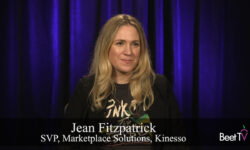If you want to know what’s really happening in the evolution of TV ad pricing, ask a man who can see almost every TV ad invoice in America.
In this video interview with Beet.TV, Ben Tatta of ad price intelligence provider Standard Media Index says ad buyers are adding OTT channels on to conventional linear buys.
Tatta says premium OTT TV ad prices are going gangbusters. But how long will that continue?
The all-seeing SMI
Standard Media Index (SMI) says it has sight of 90% of all ad agency invoices, piped straight from booking systems – aggregated and anonymized.
It then makes it available back to agencies, publishers and hedge funds as intelligence, to variously understand ad pricing, product trends and TV events.
SMI was founded a decade ago. It sells aggregate, normalized ad pricing data back to agencies so that they can understand ad pricing within their market and can effectively benchmark spending levels.
The company also provides industry ad spend forecasts.
TV’s pie is growing
With that footprint, SMI president Tatta says he sees a big recent growth in OTT TV advertising.
“Early on, it was a lot of the digital-first advertisers that are trying to really buy inventory across all digital platforms,” he says.
“(But), over the last six months, we’ve seen more conventional linear advertisers moving money into OTT. For them, it’s about reach optimization.”
Tatta says the growth is not coming strictly from budget moving out of linear.
“It’s not like they’re declining their linear budgets,” he says. “It’s really augmenting that so that they can reach audiences that they’re currently not reaching a linear.
“There is a portion of conventional linear budgets that have moved over and there’s a portion of linear budgets that have been spread out across the assets.”
Prices going up
In OTT platforms, TV ads benefit from digital-style capabilities, like targeting, frequency-capping and better analytics.
But such platforms typically carry fewer, shorter ads, as they have to compete with ad-free premium VOD offerings.
Tatta says the confluence of those two dynamics is causing a surge in OTT TV ad rates.
“What’s amazing to me is just the premiums that are associated with OTT,” he says. “Network OTT in particular has set a new premium pricing tier that didn’t exist before, in some cases that’s higher than even linear.
“I thought it would take a while to get there. I will caveat it that some of that is due to scarcity. Even though there are a lot of new services, the ad loads are lighter, so there’s fewer, ad placements, less inventory to sell, the fact that they’re commanding those kind of rates, I think is a really good sign of what happens once more digital-like capabilities are integrated into the conventional TV.
“You can get a sense of what those premiums could be based on what has happened with OTT.”
Disney searches for answers
Last year, SMI introduced its Price Intelligence Suite, an offering combining digital CPM pricing and linear video eCPM for both traditional and advanced channels.
In October, Disney Ad Sales took on the suite, allowing it to compare its own ad bookings at rates with those of competitors.
“It’s a set of pricing products, initially, that are going to focus on cross-screen videos,” Tatta says. “It includes CPMs at a publisher- and platform-level across all forms of video, whether that’s conventional user-gen, social video, OTT, or even the subcategories of OTT.
“What our data provides is the ability for them to benchmark their pricing and their spend across like services. Whether it’s a certain linear network that’s selling heavily into a certain form of sports programming, or whether it’s a competitive OTT service that they want to benchmark based on the comparative video rates, they can use it for that.”














































